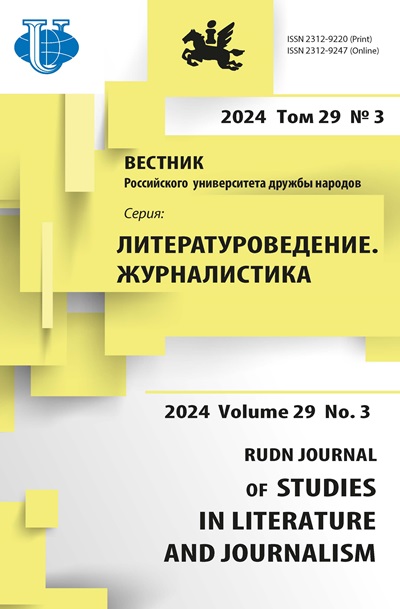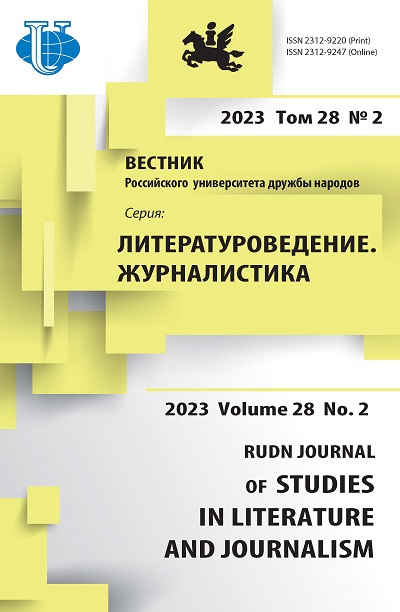European TV in the 2020s: challenges and development trends
- Authors: Ershov Y.M.1
-
Affiliations:
- Branch of Lomonosov Moscow State University in Sevastopol City
- Issue: Vol 28, No 2 (2023)
- Pages: 293-305
- Section: JOURNALISM
- URL: https://journals.rudn.ru/literary-criticism/article/view/35465
- DOI: https://doi.org/10.22363/2312-9220-2023-28-2-293-305
- EDN: https://elibrary.ru/OTFZVW
Cite item
Full Text
Abstract
The author examines the institutional originality of television in the countries of the European Union. The purpose of the study is to explain the nature of the institution of European broadcasting, which better than anything else reflects the idea of a common European home. A brief historical overview of the establishment of the European Broadcasting Union and cooperation between national broadcasters in Europe is given. The task is to identify the dynamics and trends in the development of the community of European broadcasters in the context of political, economic and technological changes in recent years. European TV is a testing ground for global TV, in which international (primarily American) and pan-European cross-border TV channels play an increasingly important role. Domestication of such channels occurs both through the localization of the content of programs, and through the titration of audio content in regional languages. The institutionalization of European television broadcasting takes place through various competitions and the activities of EU decentralized bodies, which are called upon to support joint projects in the field of TV, cinema, and the professional education of journalists (European Executive Agency for Education and Culture). At the same time, European television is not concerned about unification, keeping in mind the motto of the European Union - “In varietate сoncordia”. The diversity of the information space of the European continent is associated with the presence of several stable models for the functioning of television production, as well as with regional cultures that influence both media consumption patterns and television viewing volumes.
About the authors
Yuri M. Ershov
Branch of Lomonosov Moscow State University in Sevastopol City
Author for correspondence.
Email: ershovym@my.msu.ru
ORCID iD: 0000-0003-3526-3727
Doctor of Philology, Professor, Professor of the Department of Journalism
7 Geroyev Sevastopolya St, Sevastopol, 299001, Russian FederationReferences
- Anderson B. (1983). Imagined communities: Reflections on the origin and spread of nationa- lism. London, New York: Verso.
- Bakulev, G.P. (1994). Television without borders: Satellite channels in Europe. Moscow: VGIK Publ. (In Russ.)
- Billig, М. (1995). Banal nationalism. Sage. https://doi.org/10.4135/9781446221648
- Bodrunova, S.S. (2013). Principles of European regulation of the television sector: Market liberalization or protection of democracy through TV? Uchenye zapiski St. Petersburg University of Management Technologies and Economics, 44(4), 105–115. (In Russ.)
- Bourdon, J. (2007). Unhappy engineers of the European soul: The EBU and the woes of pan-European television. International Communication Gazette, 69(3), 263–280. https://doi.org/10.1177/1748048507076580
- Chalaby, J.K. (2016). Television and globalization: The TV content global value chain. Journal of Communication, 66(1), 35–59. https://doi.org/10.1111/jcom.12203
- Ershov, Yu.М. (2011). Idea of transfrontier television in Europe and its resonance in Russia. Vestnik NSU. Series: History and Philology, 10(6), 42–50. (In Russ.)
- Esser, A. (2014). European television programming. In R. Robertson (Ed.), European Gloca- lization in Global Context. Europe in a Global Context (pp. 82–102). London: Palgrave Macmillan. https://doi.org/10.1057/9780230390805_5
- Gripsrud, J. (Ed.). (2010). Relocating television: Television in the digital context. London: Routledge. https://doi.org/10.4324/9780203851371
- Khromchenko, N.A. (1994). European television in the era of globalization of broadcasting (PhD thesis). Moscow. (In Russ.)
- Kolyvanov, E.V. (2006). Modern European concepts and models of public television (PhD thesis). Moscow. (In Russ.)
- Malik, S., Ryder, M., Marsden, S., Lawson, R., & Gee, M. (2021). BAME: A report on the use of the term and responses to it terminology review for the BBC and creative industries. Sir Lenny Henry Centre. Retrieved February 10, 2023, from https://bcuassets.blob.core.windows.net/docs/csu2021325-lhc-report--bbchighres231121-132836254614117870.pdf
- O’Connell, D. (2015). Small nation/big neighbours: Co-producing stories in a European context. In I. Bondebjerg, E.N. Redvall & A. Higson (Eds.), European Cinema and Television: Cultural Policy and Everyday Life (pp. 239–256). London: Palgrave Macmillan. https://doi.org/10.1057/9781137356888_12
- Putseva, M.D. (2019). The problem of European identity on the air of global information television. MediaAlmanac, 94(5), 24–34. (In Russ.) https://doi.org/10.30547/mediaalmanah.5.2019.2232
- Robertson, R. (2013). Situating globalisation: A relatively autobiographical intervention. In G.S. Drori, M.A. Höllerer & P. Walgenbach (Eds.), Global Themes and Local Variations in Organization and Management. Taylor & Francis. https://doi.org/10.4324/9780203139486
- Sokolova, A.V. (2014). Transborder television: History, evolution and modern state. Proceedings of Southern Federal University. Philology, (3), 168–176. (In Russ.)
- Utard, J.M. (1997). Arte: Information télévisée et construction d'un point de vue transnational: Étude d'un corpus franco-allemand (Thèse de doctorat). Strasbourg: Université Strasbourg III.
- Vachnadze, G.N. (1989). World television. Tbilisi: Ganatleba Publ. (In Russ.)
- Voitik, E.A. (2011). Structural and typological features of European sports television. Mediascope, (3). (In Russ.) Retrieved February 18, 2023, from http://www.mediascope.ru/node/888
- Wallerstein, I. (2006). European universalism: The rhetoric of power. New Press.
















